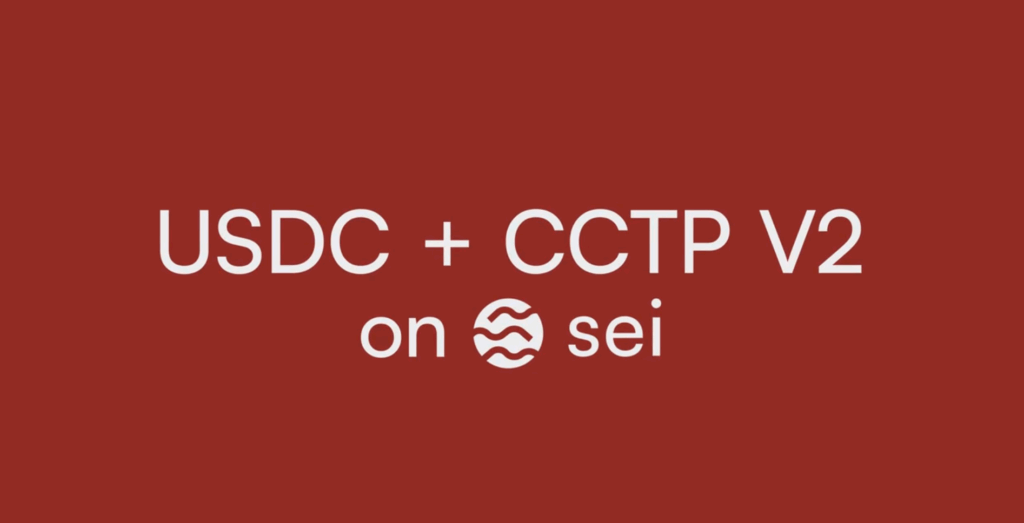Circle and Sei Network Partnership: A Milestone in Stablecoin Compliance and Cross-Chain Efficiency
On July 10, 2025, stablecoin issuer Circle announced that its compliant native USDC and upgraded cross-chain protocol CCTP V2 would officially launch on high-performance Layer 1 blockchain Sei Network by Q3 2025. This partnership marks the first deep integration of compliant stablecoins with blockchain infrastructure designed specifically for trading optimization. It aims to resolve two core issues: fragmented cross-chain liquidity and the scarcity of compliant on-chain assets.

This market insight explores the technical architecture, market impact, and regulatory implications of Circle launching native USDC and CCTP V2 on Sei Network, and its role in reshaping stablecoin competition and cross-chain user experience.
Background: Tech Complementarity and Regulatory Tailwinds
Circle’s Multichain Expansion Strategy
In November 2023, Circle’s strategic investment in Sei Network hinted at eventual technical integration. By June 2025, native USDC had launched on XRP Ledger and World Chain, covering over 27 million users. Sei becomes Circle’s 13th integrated blockchain. The key to selecting Sei lies in its performance differentiation: a parallelized EVM architecture enables 400ms transaction finality—22% faster than Solana—and peak throughput of 12,500 TPS, supporting high-frequency DeFi and gaming use cases.
Regulatory Compliance
The U.S. “GENIUS Stablecoin Act” is in progress, requiring stablecoins to be backed 100% by cash and short-term U.S. Treasuries. USDC, a fully reserved and compliant stablecoin (Circle holds NMLS license #1201441), has a first-mover advantage. Sei’s institutional-grade security design (e.g., MEV resistance) further aligns with regulatory demands, paving the way for RWA (real-world assets) scenarios.
Technical Architecture: CCTP V2 and the Cross-Chain Revolution
Native USDC Value Anchor
Unlike bridged versions, native USDC on Sei is directly issued by Circle, backed 1:1 by U.S. dollars and audited regularly by the OCC. Enterprise users can mint and redeem via Circle Mint, enabling compliant cross-border payments and on-chain settlement—filling a key gap in Sei’s compliant asset ecosystem.
Three Major Upgrades of CCTP V2
-
Frictionless Cross-Chain Transfers: Users can transfer USDC between Sei and 12 other chains (e.g., Ethereum, Base) without preloaded gas or relying on third-party bridges—solving liquidity fragmentation.
-
Hooks for Automated Actions: Supports post-cross-chain automation such as staking or trading. For example, USDC bridged from Ethereum to Sei can auto-deploy into a DEX liquidity pool.
-
Liquidity Aggregation: Integrates with cross-chain protocols like Wormhole and Axelar to unify routing and reduce slippage.
This upgrade aligns with Sei’s V3 Giga upgrade, which boosts performance by 50x via parallel processing—foundational for high-frequency trading. See JuCoin developer docs for more on cross-chain techniques.
Ecosystem Impact: Sei’s Compliance and Institutionalization
Activating High-Frequency Finance
With over 150 active projects and $363M TVL, Sei’s ecosystem processes 354K daily game-related transactions. Native USDC will:
-
Provide compliant payments for games (e.g., World of Dypians);
-
Enable high-frequency DeFi arbitrage by leveraging 400ms finality to reduce price slippage risk;
-
Support RWA settlements—for example, Plume-based real estate tokenization can use USDC for regulatory-compliant payments.
Compressing the Market for Non-Compliant Stablecoins
Previously, Sei relied on bridged USDC (e.g., Wormhole-wrapped assets), which introduced security and depeg risks. Native USDC may shrink bridge USDC’s market share from 62% to below 30%, accelerating asset compliance.
Industry Landscape: A Technological Leap in Stablecoin Competition
USDC’s Strengthened Ecosystem Moat
This integration gives Circle full coverage of two strategic domains:
-
High-Performance Chains: Sei fills the transactional L1 niche beyond Solana and Sui;
-
Compliant RWA Channels: Cooperation with RWA-focused chains like Plume creates synergy.
As of June 2025, USDC had $61.4B in circulation (40% annual growth), but still trails Tether’s 66% market share. Leveraging Sei’s performance and CCTP V2’s network, Circle may increase its market share to 35% by year-end.
Driving Public Chain Performance Upgrades
If Sei’s “400ms finality + USDC instant settlement” model proves effective, competitors like Solana and Aptos may be forced to upgrade consensus mechanisms. Industry focus will shift from raw TPS to a holistic metric: “settlement speed + compliant asset support.”
Challenges & Outlook: The Compliance-Security Tug-of-War
Regulatory Adaptation Risk
The SEC may classify yield-bearing stablecoins (e.g., interest-accruing USDC) as securities, limiting their use in Sei DeFi. Circle must co-develop regulatory frameworks to prevent innovation bottlenecks.
Cross-Chain Security Reliance
CCTP V2 still depends on third-party bridges (e.g., Wormhole). In the event of a hack, cross-chain channels could be severed. Sei has launched a $1M bug bounty but needs chain-level risk control systems.
Near-Term Catalysts
-
Giga Upgrade Launch: 50x performance boost by Q3 2025 will attract high-frequency apps.
-
EURC Expansion: Circle plans to deploy EURC on Sei to capture the European user base.
-
Traditional Payments Integration: Via partnership with Fiserv, USDC may integrate into POS systems, forming an on-off chain payment loop.
At its core, this partnership represents infrastructure fusion:
Circle’s compliant asset issuance and Sei’s unmatched performance may elevate stablecoins from “medium of exchange” to “programmable financial infrastructure.” If regulatory clarity arrives, this model could become standard across L1s, redefining value flow in Web3.
When compliance meets performance, and liquidity breaks its silos, blockchain’s era of pragmatism truly begins.





